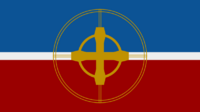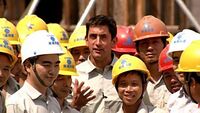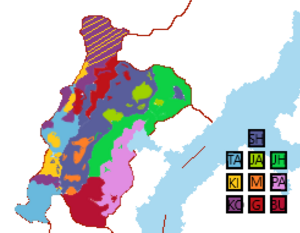Mahana: Difference between revisions
Lyooonheimer (talk | contribs) No edit summary |
mNo edit summary |
||
| Line 1: | Line 1: | ||
{{Infobox country | {{Infobox country | ||
|micronation = | |micronation = <!--yes if a micronation--> | ||
|conventional_long_name = Federal Democratic Republic of Mahana <!--Formal or official full name of the country in English--> | |conventional_long_name = Federal Democratic Republic of Mahana <!--Formal or official full name of the country in English--> | ||
|native_name = संघीय लोकतान्त्रिक गणतन्त्र महान | |native_name = संघीय लोकतान्त्रिक गणतन्त्र महान <br/> Saṅghīya lōkatāntrika gaṇatantra Mahāna ([[Mahanan]]) <!--Country's name (usually full name) in its native language, hence in italics (double quotemarks)--> | ||
|common_name = Mahana | |common_name = Mahana <!--Common name in English (used for wikilinks, captions, and to produce a default iso3166 code)--> | ||
|status = | |status = <!--Status of country, especially useful for micronations--> | ||
|image_flag = [[File:Flag of Mahana.png|200px]] | |image_flag = [[File:Flag of Mahana.png|200px]] <!--e.g. Flag of country.svg--> | ||
|alt_flag = | |alt_flag = <!--alt text for flag (text shown when pointer hovers over flag)--> | ||
|flag_border = | |flag_border = <!--set to no to disable border around the flag--> | ||
|image_flag2 = | |image_flag2 = <!--e.g. Second-flag of country.svg--> | ||
|alt_flag2 = | |alt_flag2 = <!--alt text for second flag--> | ||
|flag2_border = | |flag2_border = <!--set to no to disable border around the flag--> | ||
|image_coat = [[File: | |image_coat = [[File:Coat of arms of Mahana.png|125px]] <!--e.g. Coat of arms of country.svg--> | ||
|alt_coat = | |alt_coat = <!--alt text for coat of arms--> | ||
|symbol_type = | |symbol_type = <!--emblem, seal, etc (if not a coat of arms)--> | ||
|symbol_footnote = | |symbol_footnote = <!--optional reference or footnote for the symbol caption--> | ||
|national_motto = "Adbhuta pahāḍī rājya" | |national_motto = "Adbhuta pahāḍī rājya" <!--in inverted commas and wikilinked if link exists--> | ||
|englishmotto = "Bound by Democracy" | |englishmotto = "Bound by Democracy" <!--English language version of motto--> | ||
|national_anthem = [https://www.youtube.com/watch?v=Jb4T9SS2d_s Shreeman Gambhir] [[File:Screenshot_2021-04-14_212901.png|250px]] | |national_anthem = [https://www.youtube.com/watch?v=Jb4T9SS2d_s Shreeman Gambhir] [[File:Screenshot_2021-04-14_212901.png|250px]] <!--in inverted commas and wikilinked if link exists--> | ||
|royal_anthem = | |royal_anthem = <!--in inverted commas and wikilinked if link exists--> | ||
|other_symbol_type = | |other_symbol_type = <!--Use if a further symbol exists, e.g. hymn--> | ||
|other_symbol = | |other_symbol = | ||
|image_map =[[File:Screenshot 2021-12-27 140129.png|200px]] <br> | |image_map =[[File:Screenshot 2021-12-27 140129.png|200px]] <br/> [[File:Screenshot 2021-12-27 142421.png|200px]] <!--e.g. LocationCountry.svg--> | ||
|loctext = | |loctext = <!--text description of location of country--> | ||
|alt_map = | |alt_map = <!--alt text for map--> | ||
|map_caption = (top) Mahana | |map_caption = (top) Location of Mahana on [[Eurth]] <br/> (bottom) Mahana in [[Europa (continent)|Europa]] <!--Caption to place below map--> | ||
|image_map2 = | |image_map2 = <!--Another map, if required--> | ||
|alt_map2 = | |alt_map2 = <!--alt text for second map--> | ||
|map_caption2 = | |map_caption2 = <!--Caption to place below second map--> | ||
|capital = | |capital = <!--Name of country/territory's capital, wikilinked if link exists--> | ||
|coordinates = | |coordinates = <!-- Coordinates for capital, using {{tl|coord}} --> | ||
|largest_city = [[Jutpandi]] | |largest_city = [[Jutpandi]] <!--Name of country/territory's largest city. Use "capital" (without quotation marks) if it's the capital.--> | ||
|largest_settlement_type = city <!--Type of settlement if largest settlement not a city--> | |largest_settlement_type = city <!--Type of settlement if largest settlement not a city--> | ||
|largest_settlement = <!--Name of largest settlement--> | |largest_settlement = <!--Name of largest settlement--> | ||
|official_languages = [[Mahanan]] <!--Languages recognised in legislation, constitution, etc--> | |official_languages = [[Mahanan]] <!--Languages recognised in legislation, constitution, etc--> | ||
|national_languages = <!--Country/territory-wide languages recognised but not necessarily in country/territory-wide law, etc--> | |national_languages = <!--Country/territory-wide languages recognised but not necessarily in country/territory-wide law, etc--> | ||
|regional_languages = | |regional_languages = {{wp|Bhojpuri language|Sanpujri}} <br/> {{wp|Gurung language|Gurung}} <!--Languages recognised or associated with particular regions within the country/territory--> | ||
|languages_type = | |languages_type = <!--Use to specify a further type of language, if not official, national or regional--> | ||
|languages = | |languages = <!--Languages of the further type--> | ||
|languages_sub = | |languages_sub = <!--Is this further type of language a sub-item of the previous non-sub type? ("yes" or "no")--> | ||
|languages2_type = | |languages2_type = <!--Another further type of language--> | ||
|languages2 = | |languages2 = <!--Languages of this second further type--> | ||
|languages2_sub = | |languages2_sub = <!--Is the second alternative type of languages a sub-item of the previous non-sub type? ("yes" or "no")--> | ||
|ethnic_groups = | |ethnic_groups = 16.6% [[Sheshtri]] <br/> 12.2% [[Gaimreti]] <br/> 7.1% [[Mai]] <br/> 6.6% [[Tamang]] <br/> 5.8% [[Jhimpe]] <br/> 5% [[Jamuni]] <br/> 4.4% [[Butwali]] <br/> 4% [[Koshi]] <br/> 2.3% [[Kiralimbu]] <br/> 2% [[Pashimari]] <br/> 1.5% [[Shivalaya]] <br/> 21.93% Other Ethnic Groups <!--List/breakdown of ethnic groups within the country/territory--> | ||
|ethnic_groups_year = 2012 <!--Year of ethnic groups data (if provided)--> | |ethnic_groups_year = 2012 <!--Year of ethnic groups data (if provided)--> | ||
|ethnic_groups_ref = National Census <!--(for any ref/s to associate with ethnic groups data)--> | |ethnic_groups_ref = National Census <!--(for any ref/s to associate with ethnic groups data)--> | ||
|religion = 81.3% [[Gaism]] <br> 9.0% | |religion = 81.3% [[Gaism]] <br/> 9.0% {{wp|Buddhism in Nepal|Buddhism}} <br/> 4.4% {{wp|Hinduism in Nepal|Hinduism}} <br/> 3.1% {{wp|Kirat Mundhum|Kirant}} <br/> 1.4% {{wp|Islam in Nepal|Islam}} <br/> 0.5% {{wp|Christianity in Nepal|Christianity}} <br/> 0.5% {{wp|Nature worship|Prakriti}} <br/> 0.3% Others <!--Religion--> | ||
|religion_year = <!--Year of religion data (if provided)--> | |religion_year = <!--Year of religion data (if provided)--> | ||
|religion_ref = <!--(for any ref/s to associate with religion data)--> | |religion_ref = <!--(for any ref/s to associate with religion data)--> | ||
|demonym = | |demonym = <!--Term/s describing those associated with the country/territory (e.g. "Belgian" for the country Belgium)--> | ||
|government_type = | |government_type = <!--(often a compound multi-wikilinked term, e.g. "Federal semi-presidential constitutional republic", etc)--> | ||
|leader_title1 = Prime-Minister<!--(for a country, usually the head of state's (wikilinked) title, e.g. "President", "Monarch")--> | |leader_title1 = Prime-Minister<!--(for a country, usually the head of state's (wikilinked) title, e.g. "President", "Monarch")--> | ||
|leader_name1 = [[Ranju Bastola]] | |leader_name1 = [[Ranju Bastola]] | ||
|leader_title2 = President | |leader_title2 = President <!--(could be "Vice President", otherwise "Prime Minster", etc, etc)--> | ||
|leader_name2 = [[Bina Sharma]] | |leader_name2 = [[Bina Sharma]] | ||
|leader_title3 = | |leader_title3 = | ||
|leader_name3 = | |leader_name3 = | ||
<!--......--> | <!--......--> | ||
|leader_title14 = | |leader_title14 = <!--(up to 14 distinct leaders may be included)--> | ||
|leader_name14 = | |leader_name14 = | ||
|legislature = [[Federal Parliament of Mahana|Federal Parliament]] | |legislature = [[Federal Parliament of Mahana|Federal Parliament]] <!--Name of the country/territory's governing body, e.g. "Parliament", "Congress", etc--> | ||
|upper_house = [[Mahanan National Assembly|National Assembly]] | |upper_house = [[Mahanan National Assembly|National Assembly]] <!--Name of governing body's upper house, if given (e.g. "Senate")--> | ||
|lower_house = [[Mahanan House of Representatives|House of Representatives]] | |lower_house = [[Mahanan House of Representatives|House of Representatives]] <!--Name of governing body's lower house, if given (e.g. "Chamber of Deputies")--> | ||
|sovereignty_type = | |sovereignty_type = <!--Brief description of country/territory's status ("Independence [from...]", "Autonomous province [of...]", etc)--> | ||
|sovereignty_note = | |sovereignty_note = | ||
|established_event1 = <!--First key event in history of country/territory's status or formation--> | |established_event1 = <!--First key event in history of country/territory's status or formation--> | ||
|established_date1 = | |established_date1 = <!--Date of first key event--> | ||
|established_event2 = <!--Second key event--> | |established_event2 = <!--Second key event--> | ||
|established_date2 = | |established_date2 = <!--Date of second key event--> | ||
<!--......--> | <!--......--> | ||
|established_event13 = <!--(up to 13 distinct events may be included)--> | |established_event13 = <!--(up to 13 distinct events may be included)--> | ||
|established_date13 = | |established_date13 = | ||
|area_rank = | |area_rank = | ||
|area = | |area = <!--Major area size (in [[Template:convert]] either km2 or sqmi first)--> | ||
|area_km2 = | |area_km2 = <!--Major area size (in square km)--> | ||
|area_sq_mi = | |area_sq_mi = <!--Area in square mi (requires area_km2)--> | ||
|area_footnote = | |area_footnote = <!--Optional footnote for area--> | ||
|percent_water = | |percent_water = | ||
|area_label = | |area_label = <!--Label under "Area" (default is "Total")--> | ||
|area_label2 = | |area_label2 = <!--Label below area_label (optional)--> | ||
|area_data2 = | |area_data2 = <!--Text after area_label2 (optional)--> | ||
|population_estimate = 27,450,000 | |population_estimate = 27,450,000 | ||
|population_estimate_rank = | |population_estimate_rank = | ||
| Line 88: | Line 88: | ||
|population_density_sq_mi = | |population_density_sq_mi = | ||
|population_density_rank = | |population_density_rank = | ||
|nummembers = | |nummembers = <!--An alternative to population for micronation--> | ||
|GDP_PPP = $127.22 billion | |GDP_PPP = $127.22 billion <!--(Gross Domestic Product from Purchasing Power Parity)--> | ||
|GDP_PPP_rank = | |GDP_PPP_rank = | ||
|GDP_PPP_year = 2021 | |GDP_PPP_year = 2021 | ||
| Line 99: | Line 99: | ||
|GDP_nominal_per_capita = | |GDP_nominal_per_capita = | ||
|GDP_nominal_per_capita_rank = | |GDP_nominal_per_capita_rank = | ||
|Gini = 32.6 | |Gini = 32.6 <!--(Gini measure of income inequality; input number only; valid values are between 0 and 100)--> | ||
|Gini_ref = | |Gini_ref = <!--(for any ref/s to associate with Gini number)--> | ||
|Gini_rank = | |Gini_rank = | ||
|Gini_year = | |Gini_year = | ||
|HDI_year = | |HDI_year = <!-- Please use the year to which the data refers, not the publication year--> | ||
|HDI = | |HDI = <!--(Human Development Index; input number only; valid values are between 0 and 1)--> | ||
|HDI_change = | |HDI_change = <!--increase/decrease/steady; rank change from previous year--> | ||
|HDI_rank = | |HDI_rank = | ||
|HDI_ref = | |HDI_ref = <!--(for any ref/s to associate with HDI number)--> | ||
|currency = [[Mahanan Rupee]] | |currency = [[Mahanan Rupee]] <!--Name/s of currency/ies used in country/territory--> | ||
|currency_code = | |currency_code = <!--ISO 4217 code/s for currency/ies (each usually three capital letters)--> | ||
|time_zone = UTC+8 | |time_zone = UTC+8 <!--e.g. GMT, PST, AST, etc, etc (wikilinked if possible)--> | ||
|utc_offset = | |utc_offset = <!--in the form "+N", where N is number of hours offset--> | ||
|time_zone_DST = | |time_zone_DST = <!--Link to DST (Daylight Saving Time) used, otherwise leave empty--> | ||
|utc_offset_DST = | |utc_offset_DST = <!--in the form "+N", where N is number of hours offset--> | ||
|DST_note = | |DST_note = <!--Optional note regarding DST use--> | ||
|antipodes = | |antipodes = <!--Place/s exactly on the opposite side of the world to country/territory--> | ||
|date_format = | |date_format = <!--all-numeric date format and era, such as [[Common Era|CE]], [[Anno Domini|AD]], [[Hijri year|AH]], etc.; e.g. {{abbr|yyyy|year}}-{{abbr|mm|month}}-{{abbr|dd|day}} ([[Anno Domini|AD]]) --> | ||
|drives_on = left | |drives_on = left <!--"right" or "left" (side of road)--> | ||
|cctld = | |cctld = <!--Internet country code top-level domain identifier (e.g. [[.br]], [[.de]], etc) | ||
|iso3166code = | |iso3166code = <!--Use to override default from common_name parameter above; omit using "omit".--> | ||
|calling_code = +989 | |calling_code = +989 <!--e.g. [[+1]], [[+531]], [[+44]], etc--> | ||
|patron_saint = | |patron_saint = <!--Use patron_saints for multiple--> | ||
|image_map3 = | |image_map3 = <!--Optional third map position, e.g. for use with reference to footnotes below it--> | ||
|alt_map3 = | |alt_map3 = <!--alt text for third map position--> | ||
|footnote_a = | |footnote_a = <!--For any footnote <sup>a</sup> used above--> | ||
|footnote_b = | |footnote_b = <!--For any footnote <sup>b</sup> used above--> | ||
<!--......--> | <!--......--> | ||
|footnote_h = | |footnote_h = <!--For any footnote <sup>h</sup> used above--> | ||
|footnotes = | |footnotes = <!--For any generic non-numbered footnotes--> | ||
}} | }} | ||
| Line 160: | Line 160: | ||
Mahana is hugely biodiverse nation, with the country often put into three sub-categories; the 'Plateau', which is the [[Careleon Plateau]], the 'Highlands', which is the [[Samripe Mountain Range]] and the 'Lowlands' which make up the south-western part of the nation. | Mahana is hugely biodiverse nation, with the country often put into three sub-categories; the 'Plateau', which is the [[Careleon Plateau]], the 'Highlands', which is the [[Samripe Mountain Range]] and the 'Lowlands' which make up the south-western part of the nation. | ||
==History== | ==History== | ||
| Line 189: | Line 190: | ||
==Politics== | ==Politics== | ||
Mahana is a Federal Democratic Republic. | Mahana is a Federal Democratic Republic. | ||
| Line 198: | Line 198: | ||
Legislature: Federal Parliament (bicameral | Legislature: Federal Parliament (bicameral | ||
* Upper house: National Assembly | * Upper house: National Assembly | ||
* Lower house: House of Representatives | * Lower house: House of Representatives | ||
==Economy== | ==Economy== | ||
{{main|Economy of Mahana}} | |||
Mahana's GDP (Gross Domestic Product) for 2021 was $36.084 billion with an annual growth rate calculated at 4.9% in 2021, which is expected to rise to 6.5% by 2025. Mahana could be considered to be one of the fastest growing economies in [[Europa]], however with one of the lowest GDP nominal per capita. | Mahana's GDP (Gross Domestic Product) for 2021 was $36.084 billion with an annual growth rate calculated at 4.9% in 2021, which is expected to rise to 6.5% by 2025. Mahana could be considered to be one of the fastest growing economies in [[Europa]], however with one of the lowest GDP nominal per capita. | ||
[[File:P01h02yb.jpg|200px|thumb|right|The Worker Force in Mahana.]] | [[File:P01h02yb.jpg|200px|thumb|right|The Worker Force in Mahana.]] | ||
The 17.9-million-worker Mahanan Worker Force is one of the largest on [[Eurth]]. Primary work sectors make up to 34.2% of GDP, the secondary 14.3% and the tertiary 51.5%. Major agricultural products include tobacco, potato, oilseed, jute, cereal (barley, maize, millet, paddy and wheat) and milk. Major industries include tourism, cigarettes, textiles, cementing, rice, sugar and bricks. Mahana's international trade expanded greatly in the 1990s as a complete democratic system was restored. Mahana's economy was ruined in the 1990s following the [[Mahanan Civil War]]. Major exports of Mahana include leather, carpet, medicinal herbs and paper product. Major imports of Mahana include machinery, raw materials, plastic, tea, electrical and electronic devices, gold and semi-finished goods. | The 17.9-million-worker Mahanan Worker Force is one of the largest on [[Eurth]]. Primary work sectors make up to 34.2% of GDP, the secondary 14.3% and the tertiary 51.5%. Major agricultural products include tobacco, potato, oilseed, jute, cereal (barley, maize, millet, paddy and wheat) and milk. Major industries include tourism, cigarettes, textiles, cementing, rice, sugar and bricks. Mahana's international trade expanded greatly in the 1990s as a complete democratic system was restored. Mahana's economy was ruined in the 1990s following the [[Mahanan Civil War]]. Major exports of Mahana include leather, carpet, medicinal herbs and paper product. Major imports of Mahana include machinery, raw materials, plastic, tea, electrical and electronic devices, gold and semi-finished goods. | ||
[[File:Women_Working_in_the_Rice_Fields_at_Khiji_Nepal.jpg|200px|thumb|left|Two-thirds of the Mahanan workforce is employed in agriculture]] | [[File:Women_Working_in_the_Rice_Fields_at_Khiji_Nepal.jpg|200px|thumb|left|Two-thirds of the Mahanan workforce is employed in agriculture]] | ||
In recent years Mahana has made great progress in poverty reduction as well as reducing the gap in development. In 2010 Mahana was below the International Poverty Line (AIA$1.90 per person per day) from 17.3% to just 9.9% in 2019, however vulnerability still remains high as almost 34% of the population living on between $1.90 and $3.45 per day. However, Mahana has made great improvements to sectors such as infant mortality, nutrition, electricity and access to internet. On the current trajectory, Mahana is set to eliminate poverty within the next 35 years. Mahana's agricultural sector comes under great risk as during the months June-September the [[Narope Rains]] cause floods in the lowland regions, which Mahana relies on for a lot of the farming. As of 2014, Agriculture employs 76% of the workforce, services 18%, and manufacturing and craft-based industry 6%. | In recent years Mahana has made great progress in poverty reduction as well as reducing the gap in development. In 2010 Mahana was below the International Poverty Line (AIA$1.90 per person per day) from 17.3% to just 9.9% in 2019, however vulnerability still remains high as almost 34% of the population living on between $1.90 and $3.45 per day. However, Mahana has made great improvements to sectors such as infant mortality, nutrition, electricity and access to internet. On the current trajectory, Mahana is set to eliminate poverty within the next 35 years. Mahana's agricultural sector comes under great risk as during the months June-September the [[Narope Rains]] cause floods in the lowland regions, which Mahana relies on for a lot of the farming. As of 2014, Agriculture employs 76% of the workforce, services 18%, and manufacturing and craft-based industry 6%. | ||
| Line 216: | Line 219: | ||
===Tourism=== | ===Tourism=== | ||
Mahana | {{main|Tourism in Mahana}} | ||
===Foreign Employment=== | ===Foreign Employment=== | ||
| Line 231: | Line 232: | ||
(WIP. Based heavily on Nepali and Northern Indian culture.<ref>[https://www.europans.com/topic/6508-vision-statement-mahana/?do=findComment&comment=40018695 Vision statement of Mahana] (11 December 2021)</ref>) | (WIP. Based heavily on Nepali and Northern Indian culture.<ref>[https://www.europans.com/topic/6508-vision-statement-mahana/?do=findComment&comment=40018695 Vision statement of Mahana] (11 December 2021)</ref>) | ||
=== | ===Ethnic Groups=== | ||
{{main|Ethnic Makeup of Mahana}} | |||
[[File:Map of cultures in Mahana.png|thumb|Map of cultures in Mahana.]] | [[File:Map of cultures in Mahana.png|thumb|Map of cultures in Mahana.]] | ||
| Line 243: | Line 243: | ||
The most followed religion in [[Gaism]], a religion centred around the worship of the bovine God of [[Kuladara]]. | The most followed religion in [[Gaism]], a religion centred around the worship of the bovine God of [[Kuladara]]. | ||
===Cuisine=== | |||
{{main|Mahanan Cusine}} | |||
===Arts=== | ===Arts=== | ||
==References== | ==References== | ||
{{Reflist}} | {{Reflist}} | ||
{{Eurth}} | {{Eurth}} | ||
[[Category:Mahana]] | [[Category:Mahana]] | ||
{{Region icon Eurth}} | {{Region icon Eurth}} | ||
Revision as of 18:27, 17 January 2022
Federal Democratic Republic of Mahana संघीय लोकतान्त्रिक गणतन्त्र महान Saṅghīya lōkatāntrika gaṇatantra Mahāna (Mahanan) | |
|---|---|
Coat of arms
| |
Motto: "Adbhuta pahāḍī rājya" "Bound by Democracy" | |
Anthem: Shreeman Gambhir | |
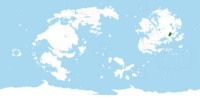 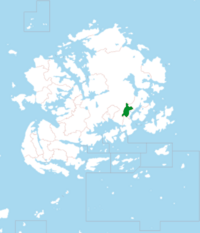 | |
| Largest city | Jutpandi |
| Official languages | Mahanan |
| Recognised regional languages | Sanpujri Gurung |
| Ethnic groups (2012)National Census | 16.6% Sheshtri 12.2% Gaimreti 7.1% Mai 6.6% Tamang 5.8% Jhimpe 5% Jamuni 4.4% Butwali 4% Koshi 2.3% Kiralimbu 2% Pashimari 1.5% Shivalaya 21.93% Other Ethnic Groups |
| Religion | 81.3% Gaism 9.0% Buddhism 4.4% Hinduism 3.1% Kirant 1.4% Islam 0.5% Christianity 0.5% Prakriti 0.3% Others |
| Government | |
• Prime-Minister | Ranju Bastola |
• President | Bina Sharma |
| Legislature | Federal Parliament |
| National Assembly | |
| House of Representatives | |
| Population | |
• 2021 estimate | 27,450,000 |
• 2012 census | 27,437,492 |
| GDP (PPP) | 2021 estimate |
• Total | $127.22 billion |
• Per capita | $1,867 |
| GDP (nominal) | 2021 estimate |
• Total | $36.084 billion |
| Gini | 32.6 medium |
| Currency | Mahanan Rupee |
| Time zone | UTC+8 |
| Driving side | left |
| Calling code | +989 |
Mahana (Mahanan: महान or Mahāna|IPA: mæhˈɑːnə ( listen), officially the Federal Democratic Republic of Mahana is a country in Europa, more specifically the sub-continent of Orient, which consists of 27 million people. The capital city is Jutpandi but other large cities include Ghobari, Battagara and Veydu. The most notable feature of Mahana is the Samripe Mountain Range, one of the largest on Eurth, and specifically Mount Monjara, standing at 7,963m tall. The most followed religion in Gaism, a religion centred around the worship of the bovine God of Kuladara. Mahana is made up of a huge amount of differing ethnic peoples, including the Sheshtri, Gaimreti and the Mais. The name 'Mahana' literally translates to 'Great' in the native language.
Mahana, despite historically being isolationist, currently have positive relations with a majority of Eurths countries. The nation has been a democracy since the Mahanan Civil War of the early 1990s, which overthrew the Monarchy in Mahana. The current Prime-Minister is Ranju Bastola and President is Bina Sharma. The current Queen is Sharma II, however the title is more of a 'show title' in present day.
Etymology
The term 'Mahana' first appeared upon initial unification in the 13th century, during the Sapkota Dynasty. In Old Mahanan (पुरानो महन्त लिपि) the word is thought to originally have meant 'Land of the Great Kings'. However the legitimacy of this claim is questioned and the true origins of the name are unknown, thought to be by some to originate from the Ancient Oharic language.
Geography
The most notable feature of Mahana is the Samripe Mountain Range, one of the largest on Eurth, and specifically Mount Monjara, standing at 7,963m tall.
(WIP. The majority of the nation's population live behind the Samripe Mountain range. This includes all the major ethnic groups. The 'lowland' ethnic groups would be the first ones to have interaction with other countries, as they are located by the sea. I haven't figured out when the lowland peoples arrived or where they came from yet, but I do know that they are ethnically quite different from the mountainous groups.)
Biodiversity
Mahana is hugely biodiverse nation, with the country often put into three sub-categories; the 'Plateau', which is the Careleon Plateau, the 'Highlands', which is the Samripe Mountain Range and the 'Lowlands' which make up the south-western part of the nation.
History
Ancient Mahana
- Prehistory — (WIP. Inspiration can be found in this reference of Meluhha. This could also be the coastal area southeast of you. Several nearby places all begin with the letter "M": Miiros, Mekabiri, Mahana, Mantella.)
- 100s BCE — (WIP. Integration with the Pearl Road trade network.)
- (WIP. Figure out a shared heritage with the neighbouring countries.)
Medieval Mahana
- 1000s — Mahana was established officially in the 11th century as Emperor Chamrel lead the ancient Khad peoples down the Ghobari valley and into the area of modern day Jutpandi. These early peoples were believed to have been the first to practise Gaism in the region, as well as founding the ancient city of Vaddkewatta, which is situated in modern Jutpandi.
- 1100s — These people were led by the Chamrel Dynasty until the late 12th century, when they were deposed following the Mahanan Civil War, putting the Sapkota Dynasty into power.
- 1200s — It was in the 13th century when they doubled the amount of land they occupied, roughly to the modern borders, under the Sapkota Dynasty and notably Emperor Guragai.
- 1280s — It was in the very late 13th century in which Emperor Rabi introduced the caste system to Mahana. Mahana's downfall was upon the death of Emperor Jhapali, his three sons disagreed on land inheritance, resulting in the land being split into three.
- 1350s — (WIP. Expect some coastal raids during the Orinese colonial period. This would work well with the downfall you described above. A period of internal instability would help explain an external threat.)
Mahanan Unification
- 1700s — Mahana remained in this way until it was united in the 18th century by a man named Balraj Singh who lead one of the three ununified states, Jalanpathur.
- 1875-1900 — The current borders of the nation were drawn up in the late 1800s, and have remained stable since.
Contemporary Mahana
- 1900s — In the early 1900s, a man named Sudip Subba managed to successfully take power, forcing the monarch to become a secondary power and announcing himself as supreme leader or Subban. Afterward, the kings of Mahana were only figureheads and the Subban held the real power.
- 1943 — However, in the year 1943, the Gayin (Head of the Gaism religion) stated that the Subban was not the rightful leader of Mahana at any given time, restoring power back to the king, with the Subban position fading following this.
- 1992 — The Mahanan Civil War of the early 1990s removed all power from the Monarch, with the role only being a 'show title'. Establishment of the current Federal Democratic Republic of Mahana.
- 2021 — Today, Mahana remains a poor country, with most working in farming. However, Mahana is seen to have great tourist potential, with 26 million visitors in 2020. They are exporters of materials such as plastics and soft metals, as well as tea and other goods.
Politics
Mahana is a Federal Democratic Republic.
- Monarch: Queen Sharma II
- President: Bina Sharma
- Prime-Minister: Ranju Bastola
Legislature: Federal Parliament (bicameral
- Upper house: National Assembly
- Lower house: House of Representatives
Economy
Mahana's GDP (Gross Domestic Product) for 2021 was $36.084 billion with an annual growth rate calculated at 4.9% in 2021, which is expected to rise to 6.5% by 2025. Mahana could be considered to be one of the fastest growing economies in Europa, however with one of the lowest GDP nominal per capita.
The 17.9-million-worker Mahanan Worker Force is one of the largest on Eurth. Primary work sectors make up to 34.2% of GDP, the secondary 14.3% and the tertiary 51.5%. Major agricultural products include tobacco, potato, oilseed, jute, cereal (barley, maize, millet, paddy and wheat) and milk. Major industries include tourism, cigarettes, textiles, cementing, rice, sugar and bricks. Mahana's international trade expanded greatly in the 1990s as a complete democratic system was restored. Mahana's economy was ruined in the 1990s following the Mahanan Civil War. Major exports of Mahana include leather, carpet, medicinal herbs and paper product. Major imports of Mahana include machinery, raw materials, plastic, tea, electrical and electronic devices, gold and semi-finished goods.
In recent years Mahana has made great progress in poverty reduction as well as reducing the gap in development. In 2010 Mahana was below the International Poverty Line (AIA$1.90 per person per day) from 17.3% to just 9.9% in 2019, however vulnerability still remains high as almost 34% of the population living on between $1.90 and $3.45 per day. However, Mahana has made great improvements to sectors such as infant mortality, nutrition, electricity and access to internet. On the current trajectory, Mahana is set to eliminate poverty within the next 35 years. Mahana's agricultural sector comes under great risk as during the months June-September the Narope Rains cause floods in the lowland regions, which Mahana relies on for a lot of the farming. As of 2014, Agriculture employs 76% of the workforce, services 18%, and manufacturing and craft-based industry 6%.
Besides being almost landlocked, rugged and harsh geography, poor infrastructure, ethnic tension and lack of natural resources as well as long lasting civil war tensions, the post-1990 government has done a good job stabilising the country.
Tourism
Foreign Employment
Today Mahana remains a poor country, with most working in farming. However, Mahana is seen to have great tourist potential with 26 million visitors in 2020. They are exporters of materials such as plastics and soft metals as well as tea and other goods.
(WIP. Currency: Mahanan Rupee.)
Culture
(WIP. Based heavily on Nepali and Northern Indian culture.[1])
Ethnic Groups
There are 27 million people in Mahana, including a huge amount of differing ethnic peoples, including the Sheshtri, Gaimreti and the Mais.
Religion
The most followed religion in Gaism, a religion centred around the worship of the bovine God of Kuladara.
Cuisine
Arts
References
- ↑ Vision statement of Mahana (11 December 2021)
